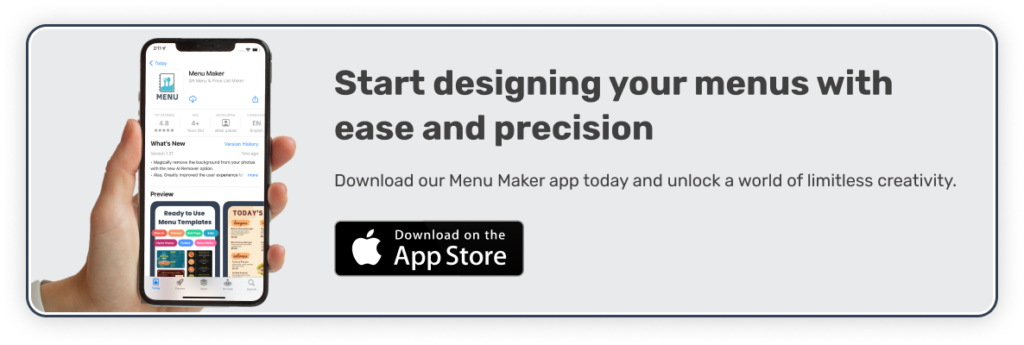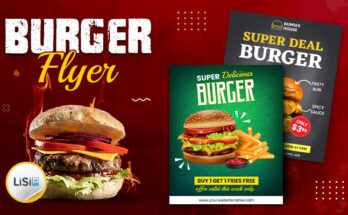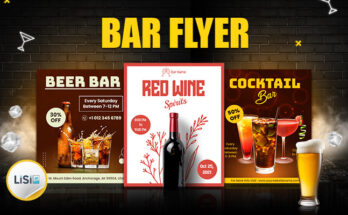From exquisite drink menu designs to captivating culinary masterpieces, indulge your senses with our exquisite selection.
In this article, we will explore the elements as well as samples of drink menu designs, providing you with valuable insights and ideas to create an irresistible beverage selection that resonates with your target audience.
Table of Content
- Samples of Drink Menu Designs
- Elements of Effective Drink Menus
- More Articles
- Menu Maker App for Mobile Phone
- Conclusion
- FAQs
Samples of Drink Menu Designs
Black Tropical Drink Menu Design
A black tropical drink menu design combines the allure of exotic flavors with a sleek and elegant aesthetic, showcasing a range of refreshing beverages with dark-colored ingredients.
Dual Color Drink Menu Design
The dual-color drink menu design uses a combination of two vibrant hues to accentuate the different drink categories, providing a visually appealing and organized layout for customers to explore and choose from.
Pink Drink Menu Design
A pink drink menu design exudes an air of whimsy charm, featuring a delightful array of beverages that showcase the beauty and allure of pink-hued ingredients.
Gird Drink Menu Designs
Grid drink menu designs utilize a structured layout with intersecting lines, creating an organized and visually appealing presentation of various beverages and their corresponding descriptions.
Leaf Background Drink Menu Design
The leaf background drink menu design embraces a botanical theme, featuring a backdrop adorned with intricate leaf patterns, which adds a touch of organic beauty to the menu and enhances the overall aesthetic of the drinks showcased.
Minimalist Drink Menu Design
A minimalist drink menu design embraces simplicity and clean lines, presenting a curated selection of beverages with minimalistic typography and ample white space for a sleek and modern aesthetic.
Now, we will explore the elements of effective drink menu designs that can make it easy to create your own drink menu for your business.
Elements of Effective Drink Menus
Layout and Structure
- Use clear and visually appealing headings and subheadings to categorize different types of drinks.
- Divide the drink options into logical categories, such as “Cocktails,” “Beer,” “Wine,” “Non-Alcoholic Beverages,” or any other relevant sections.
- Highlight key ingredients or unique features of the drink to entice their interest.
- Keep the descriptions short and engaging, capturing the essence of each drink.
- Consider the overall visual presentation of the menu. Use appropriate fonts, colors, and spacing to make the text legible and visually pleasing.
Typography and Font Selection
- Choose fonts that are easy to read. Opt for clear, sans-serif fonts for the main body text to ensure legibility, especially in dimly lit environments.
- Avoid overly decorative or script fonts that might hinder readability.
- Select fonts that align with the overall theme and atmosphere of the establishment.
- Use different font styles and sizes to differentiate headings, subheadings, and drink names.
- Prioritize readability by using appropriate font sizes. Avoid using fonts that are too small, as it can strain customers’ eyes.
Color Schemes and Visual Appeal
- Choose a combination of colors that complement or contrast each other to create visual interest.
- Use colors that reflect the overall brand identity or ambiance of the establishment.
- Ensure that the chosen colors do not overpower the text or make it difficult to read. The text should remain clear and legible against the background colors.
- Consider using contrasting colors for the text and background to ensure readability.
- Utilize colors to establish hierarchy and emphasis. Use bolder or brighter colors for headings or key sections to draw attention.
Imagery and Photography
- Use high-resolution images that are clear and visually appealing. Ensure that the images are of sufficient quality to showcase the appearance and ingredients of the beverages.
- Select images that help customers visualize the drinks they are considering. The images should accurately represent the colors, textures, and garnishes of the beverages.
- Strategically place the images alongside the drink descriptions or names.
- Avoid overcrowding the menu with too many images, as it may appear cluttered.
- Ensure that the images have a similar visual treatment, such as consistent lighting, background, or framing. Consistency contributes to a cohesive and professional menu design.
Descriptive and Engaging Content
- Incorporate enticing adjectives that evoke a sense of desire and intrigue. Use words like “refreshing,” “smooth,” “aromatic,” “bold,” “creamy,” or “exquisite” to create a favorable impression of the beverages.
- Describe the taste profiles in detail, highlighting unique combinations or standout flavors
- Incorporate storytelling elements to engage customers and create a sense of anticipation.
- Use language that appeals to the senses, allowing customers to imagine the taste, aroma, and appearance of the drinks.
- End each description with a subtle call to action that encourages customers to try the drink. Use phrases like “Discover the perfect balance of flavors,” or “Indulge in a sensory journey,” to nudge customers towards trying something new and exciting.
Pricing and Presentation
- Display prices prominently and clearly for each drink item. Ensure that they are easily visible and legible.
- Arrange the drink items in a logical order, such as by category or price range. This helps customers navigate the menu more easily and find their desired options.
- Present the menu in an attractive and visually appealing manner. Use appropriate spacing, alignment, and formatting to enhance the overall presentation.
- Maintain consistency in the format of pricing throughout the menu. For example, align all prices to the right or left side of the menu items.
- Ensure that the menu is easy to navigate, allowing customers to find the desired drink options effortlessly
In addition, there are more articles related to menu design templates that you can learn and explore to create your own menus.
More Articles:
- Weekly Menu Templates
- Modern Menu Templates
- St. Patrick’s Day Menus
- Recipe Card Templates
- Holiday Menu Templates
- Mother’s Day Menu Templates
- Boba Menu Templates
- Simple Menu Templates
- Chalkboard Menu Templates
- Food Menu Templates
- Cute Menu Templates
- Service Menu Templates
- Lunch Menu Templates
- Wine Menu Templates
- Birthday Menu Templates
- Breakfast Menu Templates
- Food Truck Menu Templates
- Dinner Menu Templates
- Christmas Menu Templates
- Thanksgiving Menu Templates
- Cafe Menu Templates
- Kids Menu Templates
- Dessert Menu Templates
- Restaurant Menu Templates
- Menu Board Design Inspiration
- Bakery Menu Templates
- Bar Menu Design Templates
- Menu Layout & Templates
- Menu Design Ideas and Examples
- Catering Menu Design Ideas & Examples
- How to Make a Menu
- Festival Menu Design Ideas and Examples
- Food Menu Design Ideas & Examples
- Best Restaurant Marketing Apps in 2023
- Menu Card Designing Using Menu Maker App: A Step-by-Step Guide
Menu Maker App for Mobile Phone
To access the menu creator app, simply tap on the buttons provided below.
Menu Maker for Android App
Menu Maker for IOS App
With the dynamic capabilities of a menu maker app, creating captivating drink menu designs has never been easier.
Conclusion
Crafting a captivating drink menu is an art that can significantly enhance the overall customer experience. By understanding your target audience, embracing creativity, and incorporating design principles, you can create a drink menu that entices, excites, and leaves a lasting impression on your patrons.
FAQs
Including prices for each drink is essential for transparency and to help customers make informed choices. However, if you have a high-end establishment or frequently update your drink offerings, you can omit the prices and mention that they are available upon request.
Regularly updating your drink menu is crucial to keep it fresh and exciting for your customers. Aim to update it at least seasonally to incorporate new flavors, ingredients, or limited-time offerings. Additionally, make sure to update it promptly whenever there are changes in prices, availability, or special promotions.
It depends on the size and focus of your establishment. Generally, it’s recommended to have a minimum of four to six categories, such as cocktails, beers, wines, spirits, non-alcoholic beverages, and seasonal specialties. Adjust the number of categories based on your target audience’s preferences and the space available on the menu.
Next Up: Drink Menu Templates













